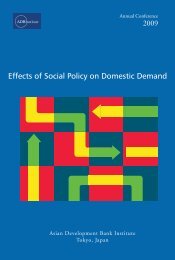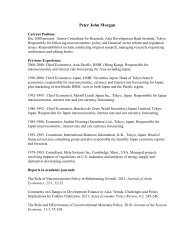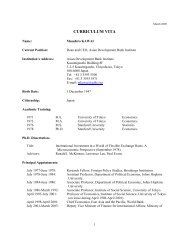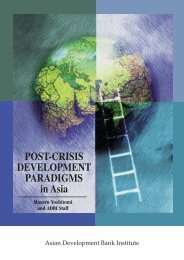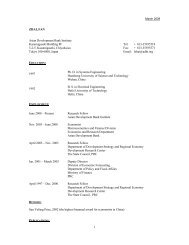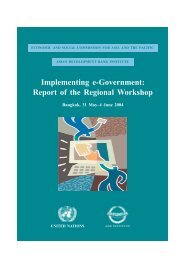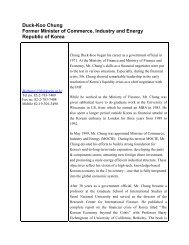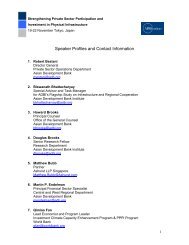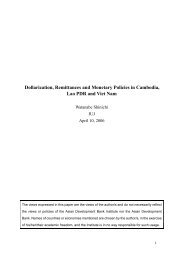Transport Infrastructure and Poverty Reduction - Asian Development ...
Transport Infrastructure and Poverty Reduction - Asian Development ...
Transport Infrastructure and Poverty Reduction - Asian Development ...
- No tags were found...
Create successful ePaper yourself
Turn your PDF publications into a flip-book with our unique Google optimized e-Paper software.
Addressing maintenance issuesQuite obviously, there is a need to discover new approaches that will guarantee a moreappropriate level of investment <strong>and</strong> better implementation of road maintenance. Since projectactivities are more visible <strong>and</strong> easier for donors to finance, one possible way of overcomingpolitical <strong>and</strong> financial constraints could be to re-package or neatly bundle maintenanceactivities into a project. In other words there might be a need to “projectify” maintenance;bundles of activities pertaining to maintenance could be packaged into a project equippedwith all the conventional elements of public projects i.e. project documentation to providedata on the problem area, the course of action required, as well as the rates of expectedreturn. As a project, maintenance activities could become viable to politicians <strong>and</strong> donors(McCawley, 2005).However, the most feasible <strong>and</strong> sustainable solution seems to lie in shifting theresponsibility of maintenance away from the government <strong>and</strong> donors towards greater costrecovery, through mechanisms such as Road Funds, or towards broader participation ofbeneficiaries at the local level. At present, there is very little involvement of beneficiaries whoare often very willing to participate in maintenance efforts, even to the extent of contributingto the cost of maintenance either in cash or in kind. While some might argue that localcontributions could not possibly be sufficient to cover the necessary expenditures,experience tells us that only very small amounts are required initially to meet maintenancerequirements. However, the costs tend to rise rapidly as deterioration progresses, exceedinglocal capacities <strong>and</strong> budgets (ADB, 2002b). Nevertheless, maintenance schemes withparticipation of the private sector in the local communities should be further encouraged.Promoting participatory project design <strong>and</strong> managementBeyond addressing maintenance issues, adopting a participatory process <strong>and</strong> givingbeneficiaries a voice in decision-making should become st<strong>and</strong>ard practice in the overalldesign <strong>and</strong> management of transport projects. Instituting some forms of local participatoryprocess is arguably the best way to ascertain the transport needs of the poor <strong>and</strong> specificsocial groups, such as women, as well as determine the kind of safeguards required by thosewho might suffer negative effects.Providing complementary servicesAll of the measures that have been proposed thus far fall within the ambit of transport sectorpolicy, but it has been demonstrated that transport infrastructure’s impact on poverty isgreatest in the presence of complementary services, which are provided by other sectors.Improvement in physical access should be integrated with other interventions such asschools, health clinics, agricultural support programs, <strong>and</strong> ICT services. This highlights theimportance of cross-sector investment planning.Minimizing the trade-offsDespite the best <strong>and</strong> most well-meaning efforts to make transport investments more propoor,the trade-off between maximizing growth <strong>and</strong> minimizing poverty reduction or the tradeoffbetween providing access/affordability <strong>and</strong> maximizing quality will continue to remainchallenging realities. Experience from PRC suggests that where income distribution isskewed, the choice of investing in rural or low-grade road to benefit the poor may be a moreappropriate choice.On the trade-off between access/affordability <strong>and</strong> quality, it seems that there should bean effort to define a set of minimum st<strong>and</strong>ards <strong>and</strong> regulations that can adequately addressthe needs of the poor. There should be a proper balance between the trade offs betweenaccess/affordability <strong>and</strong> quality, although the combination <strong>and</strong> the balance of the trade offswill tend to differ depending on prevailing conditions.8



